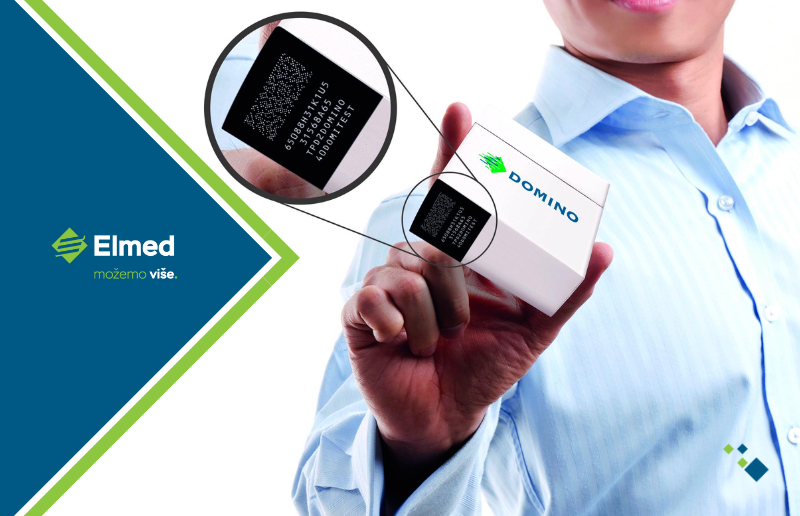What is product handling? The foundation of high-quality codes for traceability

A new dimension in barcodes
Two-dimensional barcodes are becoming a common addition to product packaging – with factors such as globalisation, online trading, and the need for stronger anti-counterfeit methods driving their uptake. In several industries, including European tobacco and pharmaceuticals, 2D codes are now a regulatory requirement.
Such is the success of 2D codes that in May of 2020 global standard organisation GS1 began an initiative to support the adoption of 2D codes at the point of sale (POS), with a new barcoding standard – the GS1 Digital Link. The standard will facilitate the use of 2D codes at point-of-sale systems and allow for a gradual transition away from standard linear barcodes.
There are multiple benefits to using 2D codes in place of traditional linear barcodes – 2D codes enable the inclusion of more information within a single code, including dynamic data, and can facilitate serialisation and wider traceability. However, the complex nature of 2D codes also presents some challenges.

The challenge behind 2D codes
It is imperative that 2D codes are printed correctly to ensure that they can be effectively scanned – this is particularly crucial when using 2D codes for regulatory purposes, such as those used in tobacco, pharmaceutical or medical devices, and will be increasingly important when considering 2D codes for use at POS.
With variable 2D codes, this presents a specific challenge, as dynamic data may require coding products that have already been packed or filled. Simply ‘bolting on’ a coding device to an existing production line may not be optimal, because often, production machinery is not designed with coding in mind.
What is product handling?
Product handling or the ‘presentation of the product’ to the coding device is fundamental to achieving high-quality codes. Manufacturers that choose to code products in-line without effective product handling will be subject to production line variations which can affect final code quality, this may include:
- Product position: Small variations in the position of products may result in codes applied in the wrong area, or missing or incomplete codes.
- Product distance from the printer: Positioning too close, or too far from the coding device can result in blurry or unreadable codes.
- Product angle: A slight rotation in product positioning, even if this is by just a few degrees, can result in deformed codes.
- Line speed: Minimal speed fluctuations will affect the quality of the code leading to squeezed or stretched codes.
- Conveyor vibrations: At high speeds, minimal vibrations can affect code quality leading to low-quality, blurred, or wavy codes.
- Challenging product geometry: Certain packaging types can be a challenge for a standard coding setup.
At best, a poor quality 2D code resulting from inadequate product handling will cause a high number of rejections, rework, and defective stock. Poor quality 2D codes can also have a knock-on effect on lines that require the aggregation of serialised products. The repercussions can be even more severe if an unreadable 2D code leaves the factory unnoticed. Brands can face hefty fines, loss of business, product recalls, and potential legal implications.

What’s the solution?
A bespoke product handling solution can solve all aforementioned issues with regard to code quality, by ensuring optimal and consistent product delivery to the coding equipment. The optimal solution will be designed based on several different considerations including:
- Product and packaging type: Factors such as the shape of a piece of packaging, substrate type, and weight of a filled pack can be crucial. Cigarette packs are light and have a regular form, but beverage cans will be more challenging to code.
- Code requirements: Code type, placement, and resolution are determining factors. Many machine-readable codes have minimum size requirements and necessitate the use of high-resolution printing technologies.
- Existing production specifications: If a coding solution is integrated into an existing production line, it will need to be designed with existing specifications in mind so as not to slow down production or reduce OEE.
Considering the above, a bespoke solution may use multiple types of technology to handle finished products and present them to the chosen coding device for final printing.
Depending on the type of product this may include robotic arms, specialised conveyors, wheels, or product carriages and movers. These devices can use different methods to handle products, with different levels of force for delicate, and robust products alike. A bespoke handler could be developed with pneumatic or servo-electric driven side or ‘Top & Bottom’ belts, as proven with Domino’s handling solution for pharmaceutical & tobacco, or even magnetic or vacuum solutions.

As well as improving overall code quality bespoke product handling solutions can also be developed to allow additional processes to enable pre- or post-treatment of a substrate, where necessary, and, when used alongside machine vision systems, can also help to give critical information for operations monitoring. The handling system will also invariably include an automated rejection device and can be used for other ‘non-coding’ requirements. A good example of this is the ‘Tax Stamp Verification’ option on the Coding Station, which checks that a Tax Stamp has been applied correctly. The same rejection device can then be utilized for either process.
Conclusion
When applying codes directly onto product packaging, it is imperative to consider whether products can be adequately coded in situ, or if a product handling solution is required. Product handling solutions, such as Domino Solutions, will help to improve overall code quality on the line, helping manufacturers to improve OEE by reducing waste, increasing production efficiency, and reducing overall running costs.
*Source: Domino news portal https://www.domino-printing.com/en/blog/2022/product-handling-blog-1-traceability?utm_source=bambu&utm_medium=social&blaid=3064262
